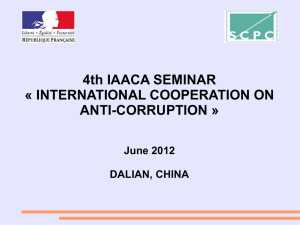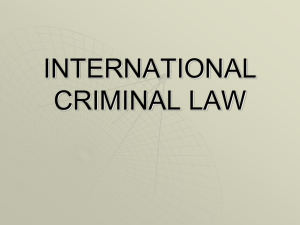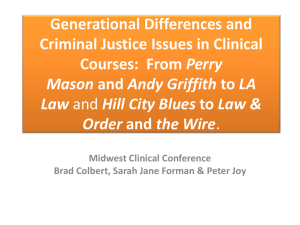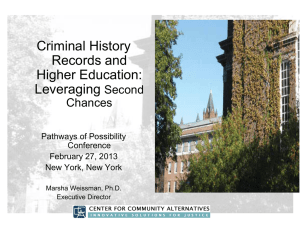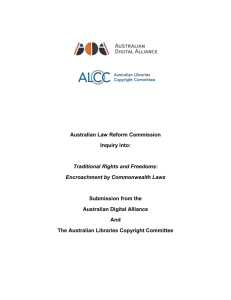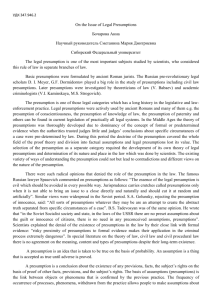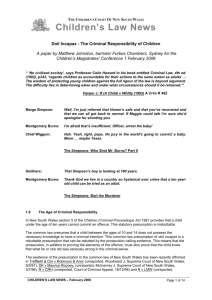Presentation - 2 December 2011 - Belgrade
advertisement
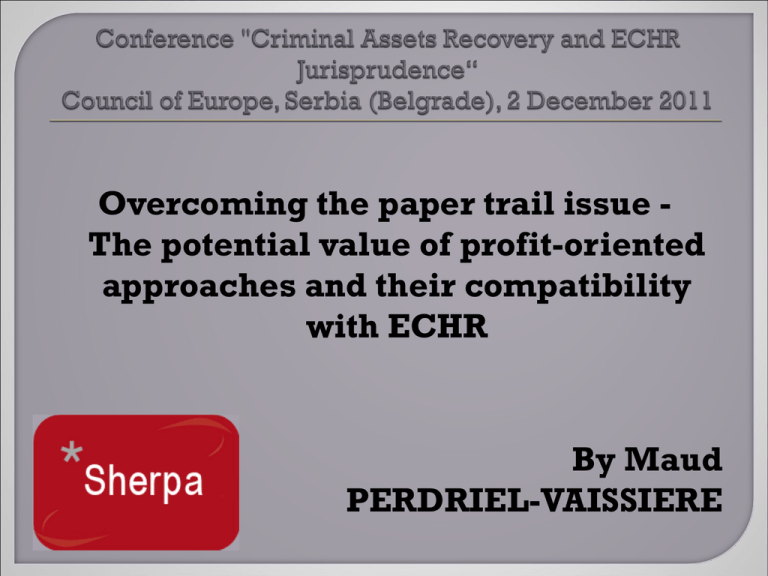
Overcoming the paper trail issue The potential value of profit-oriented approaches and their compatibility with ECHR By Maud PERDRIEL-VAISSIERE Criminal confiscation takes place as part of sentencing following conviction at trial The prosecution’s burden of proof is twofold: o o To prove all the elements of the offence in order to get a criminal conviction The task is tough because of the clandestine nature of corruption offences: no witnesses, no individual victim able to complain, statutes of limitation … To prove that the assets are derived from this criminal act The difficulty comes from the fact that offenders usually resort to opaque financial schemes in order to disguise the illegal sources of money and obscure the nexus with the criminal activities. When the assets are secreted abroad, the whole recovery process requires judicial cooperation between the victim and the recipient countries in order : (a) to trace the assets and to gather evidence for trial; (b) to secure the assets by implementing provisional freezing measures; and (a) (a) to confiscate the proceeds of corruption and eventually organize their return to the victim country There are various types of profit-oriented tools: some operate at the confiscation stage while others help getting a conviction All rely on presumptions and aim at easing the prosecution’s burden of proof. A presumption is a conclusion derived from a particular set of facts There are various forms of presumptions: o o Circumstantial evidence that facilitates the establishment of a criminal intent (mens rea) or a criminal act (actus reus); Strict liability offenses that provide a presumption of liability upon proof of the criminal act (no direct proof of mens rea is required). How does it work? o o Where a public official is shown to have received an advantage from a person seeking a government contract, it is presumed to have been conferred corruptly Under this scheme, prosecuting authorities have to prove that a payment was received (actus reus) but is relieved of establishing the mens rea. The defendant then needs to prove on the balance of probabilities that the reward was not given corruptly (the presumption is rebuttable). Is it compatible with Articles 6 § 2 of the ECHR? o o Salabiaku v. France (ECHR, 1988): “(…) The Convention does not prohibit such presumptions in principle. (…) It requires states to confine them within reasonable limits which take into account the importance of what is at stake and maintain the rights of the defence” (par. 28). Conclusion: Provisions that enshrine the right to be presumed innocent do not prohibit presumptions of fact or law (not even the creation of strict liability offences), as long as such presumptions meet the proportionality test and safeguard the rights of the defence The primary responsibility for proving matters of substance against the accused rests with the prosecution ( i.e. there is no reversal of the onus of proof) and the presumptions are rebuttable. How does it work? o o o o It allows for the confiscation of assets belonging to a convicted person upon the fact that their origin is presumed to be unlawful. It usually applies to organized crime-related offences and where there is a discrepancy between the assets and the known sources of income of the convicted. The presumption is rebuttable: no confiscation order can be made is the defendant proves that the assets are of lawful origin. The adoption of extended confiscation measures is an obligation for EU member States : Council framework decision of 24 February 2005 on Confiscation of Crime-Related Proceeds, Instrumentalities and Property. How does it work? o o o It does not require a prior criminal conviction - It allows for the confiscation of assets belonging to a person associated with a criminal organization and upon the fact that their origin is presumed to be unlawful; The presumption is rebuttable: no confiscation order can be made is the defendant proves that the assets are of lawful origin. The incrimination of offences relating to participation in a criminal organization is an obligation for EU member States : Council framework decision of 24 October 2008 on the fight against organized crime. “The structure set up by Sani Abacha and his accomplices constitutes a criminal organization since its object was to embezzle funds from the Central Bank of Nigeria for private purposes, and to profit from corrupt transactions” (par. 9.1; Swiss Supreme Court - 7 February 2005) Are these presumptions compatible with Articles 6 § 2 of the ECHR? o o o Minelli v. Switerland, 1983 : The EC ruled that the presumption of innocence applied to the criminal proceedings as a whole, and “not solely the examination of the merits of the charge” (par. 30). Philipps v. the UK, 2001: “The right to be presumed innocent under Article 6 § 2 arises only in connection with the particular offence ‘charged’. Once an accused has properly been proved guilty of that offence, Article 6 § 2 can have no application in relation to the allegations made about the accused’s character and conduct as part of the sentencing process, unless such accusations are of such a nature and degree as to amount to the bringing of a new ‘charge’” (par.35). Raimondo v. Italy, 1994: The EC ruled the confiscation of proceeds of crime under Italian anti-Mafia legislation does not amount to a criminal penalty. How does it work? o o o It penalizes public officials for having unexplained wealth well in excess of their lawful income Under this scheme, prosecuting authorities have to establish the public official’s legitimate sources of wealth, the extent of assets under his control and the discrepancy between the two. Once such a case is made, the defendant can then reverse the presumption of liability by offering a reasonable explanation that his wealth originates from legitimate sources. In other words, by establishing the possession of unexplained wealth, prosecuting authorities get at the same time the offender convicted and his assets confiscated. It is listed by the Organization for Security and Co-operation in Europe as one of the best practices for combating corruption (OSCE 2004). Does the offence of illicit enrichment trigger a reversal of the onus of proof? o o NO since the legal burden of proving “the ingredients” for the establishment of the offence remains upon the prosecution (Jaywickrama, Pope and Stolpe 2002; De Speville 1997). YES since there is a tacit presumption regarding both the actus reus (the criminal activity from which the suspicious wealth derives) and the mens rea (the criminal intent) where excessive wealth is shown (Wilsher 2006). Yet, notes Wilsher, “there is nothing inherently wrong with possessing wealth of a certain level” (Ibid). Does the offence of illicit enrichment conflict with the principle of legality ? Kokkinakis v. Greece,1993: The principle of legality “is not confined to prohibiting the retrospective application of the criminal law to an accused's disadvantage [but] also embodies the principle that only the law can define a crime and prescribe a penalty (nullum crimen, nulla poena sine lege) and the principle that the criminal law must not be extensively construed to an accused's detriment, for instance by analogy; it follows from this that an offence must be clearly defined in law. This condition is satisfied where the individual can know from the wording of the relevant provision and, if need be, with the assistance of the courts' interpretation of it, what acts and omissions will make him liable” (par.52). o o Profit-oriented approaches have a key role to play in altering “the equation of ‘risk versus reward’ that lies at the heart of many calculations when it comes to deciding whether or not to engage in corruption” (Jaywickrama, Pope and Stolpe 2002). Good justice requires good judgment. It is all about striking the right balance between the fundamental rights of the accused with the inherent right of society to recover illicitly acquired national wealth. De Speville B. 1997. “Reversing the onus of proof: is it compatible with respect human rights norms?”, paper presented at the eighth International Anti-Corruption Conference Jaywickrama N., Pope J. and Stolpe O. 2002. “Legal provisions to Facilitate the Gathering of Evidence in Corruption Cases: Easing the Burden of Proof.” Forum on Crime and Society,Vol. 2, No. 1. Wilsher, Dan. 2006. Inexplicable wealth and illicit enrichment of public officials: A model draft that respects human rights in corruption cases. Crime, Law and Social Change, Vol.45, No. 1. Kofele-Kale N. 2006.“Presumed guilty: Balancing competing rights and interests in combating economic crimes”. Journal of International Law Jorge G. 2007. “The Romanian legal framework on illicit enrichment”. American Bar Association, CEELI Program. Muzila L., Morales M., Mathias M., Berger T. 2011.“Illicit enrichment”. StAR Thank you for you attention.




